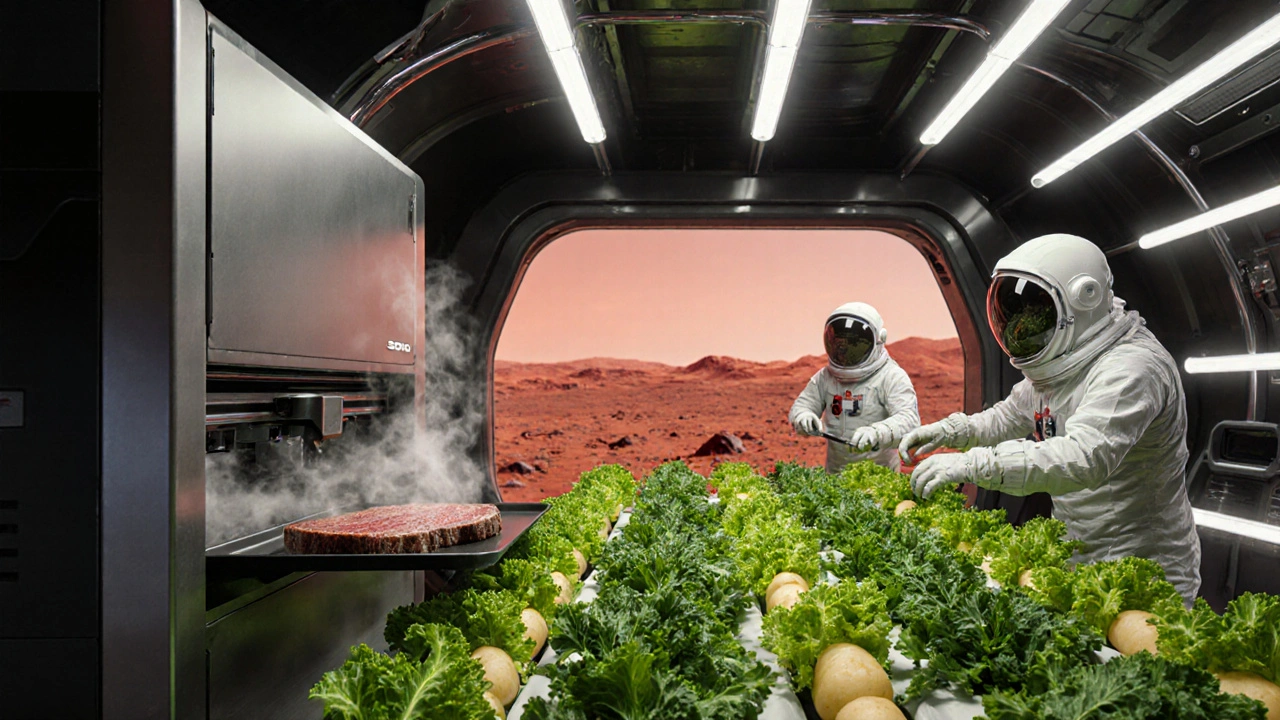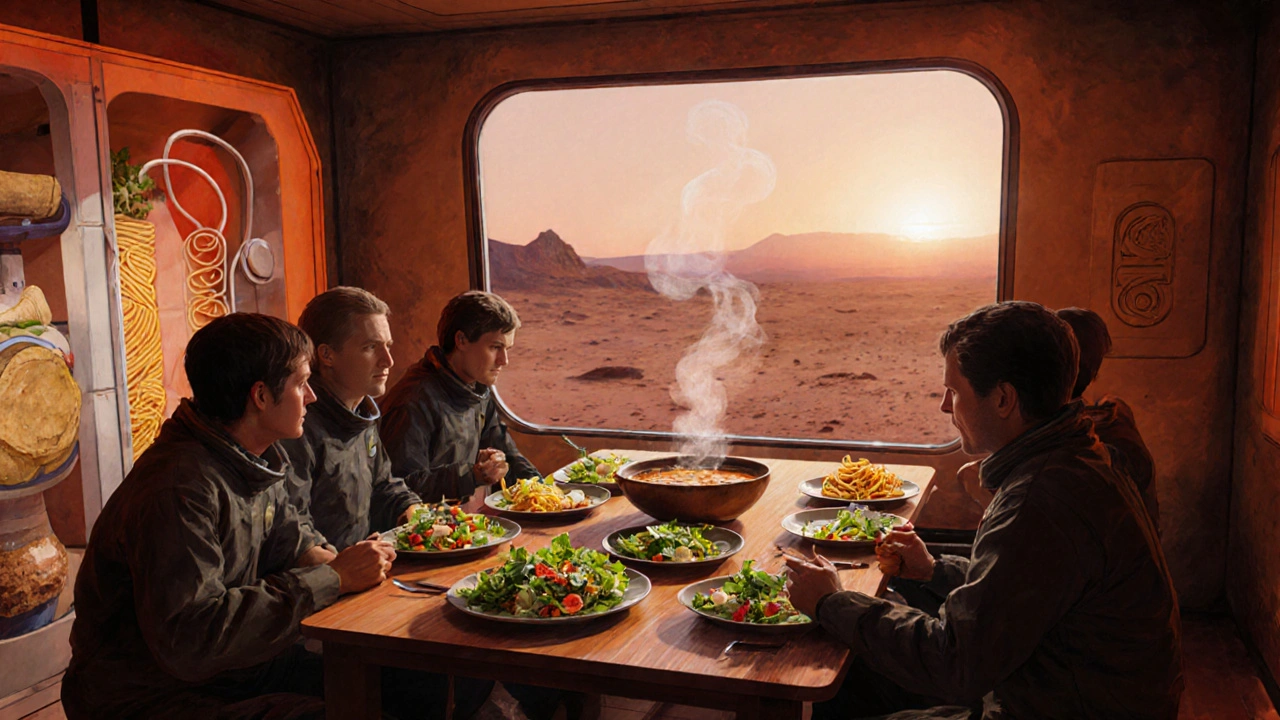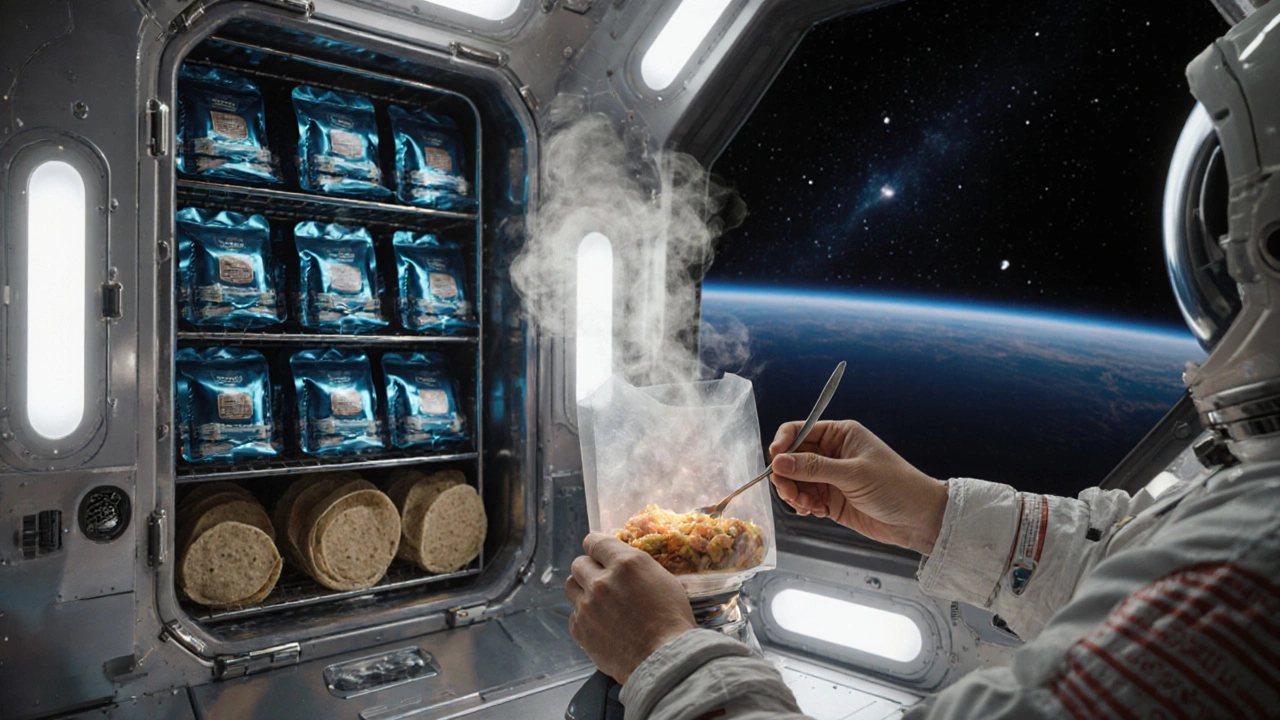Key Takeaways
- Long‑duration missions need food that stays safe, nutritious, and appealing for 3‑5 years.
- Two architectures dominate: the Transit Food System (highly packaged, low power) and the Planetary Food System (uses fresh crops).
- Nutrition, shelf stability, mass, and crew morale are the five non‑negotiable requirements.
- Bioregenerative tech - Veggie, 3D printing, in‑situ resource use - will provide up to 30% of calories by 2040.
- Menu fatigue is the biggest psychological risk; variety and sensory richness must be engineered from day one.
When you think about a trip to Mars, the first things that come to mind are rockets, radiation shields, and life‑support air. What often gets less fanfare is the food that will keep a crew alive and sane for the next three to five years. A well‑designed space food system is the backbone of any long‑duration mission because you simply can’t send resupply ships to a distant planet.
Space Food System is a specialized life‑support subsystem that provides safe, nutrient‑dense, and psychologically satisfying meals to astronauts on extended spaceflights. It evolved from the simple applesauce tubes John Glenn ate on Friendship 7 (1962) to today’s multi‑category menus on the International Space Station (ISS). The jump from 8‑day cycles on early missions to 6‑month rotations on the ISS taught us a lot, but the real test will be keeping crews fed for the full 2‑3 year Mars voyage.
Five Core Requirements
NASA’s 2010 Journal of Food Science paper distilled the needs into five pillars. Every design decision traces back to at least one of them:
- Nutrient density: Calories, protein, essential vitamins, and minerals must stay within acceptable limits for the entire storage life.
- Extended Shelf Stability - the ability to remain safe and palatable for 3‑5 years without refrigeration.
- Rigorous Food Safety standards (no detectable pathogens, < 100 aerobic bacteria g⁻¹).
- Crew Acceptability - taste, texture, and variety that support morale.
- Mass and volume reduction - every kilogram launched costs thousands of dollars.
Missing even one pillar can jeopardize mission success. For example, vitamin C degrades rapidly in freeze‑dried foods, and crews have reported reduced appetite when that loss hits critical levels.
Transit vs. Planetary Food Systems
NASA separates food architecture into two distinct models. The table below highlights how each addresses the five pillars.
| Attribute | Transit Food System | Planetary Food System |
|---|---|---|
| Shelf Life | 3‑5 years (packaged, thermostabilized, irradiated) | Fresh crops provide < 6 months, supplemented by short‑term preservation |
| Power Use | Minimal - only rehydration heaters (≈ 200 W per meal) | Higher - lighting, climate control for hydroponics (≈ 2‑3 kW per crew) |
| Mass/Volume | High initial mass, but compact packaging (≈ 0.5 kg per day) | Lower long‑term mass once crops mature; initial growth hardware adds ≈ 150 kg |
| Waste Generation | Packaging waste (multi‑layer metallized films) | Biodegradable plant waste can be recycled into compost or bioregenerative loops |
| Psychological Variety | Limited to pre‑packaged menu cycles; suffers from menu fatigue after ~90 days | Fresh salads, herbs, and on‑demand 3D‑printed meals boost morale |
Both systems will coexist on a Mars mission. During the interplanetary cruise, the Transit Food System carries the bulk of calories. Once the crew lands, the Planetary Food System ramps up, gradually replacing packaged items with fresh produce.
Current State on the International Space Station
The ISS is the testbed for today’s food technology. Its menu cycles run 8‑16 days and include:
- Natural‑form foods - fresh fruit, nuts, cookies.
- Intermediate‑moisture items - applesauce, beef jerky.
- Thermostabilized entrees - crab bisque, curried pumpkin soup.
- Dehydrated and freeze‑dried meals - mango salad, couscous with nuts.
- Crumb‑resistant tortillas - the “Swiss Army knife” of space meals.
Astronauts spend about 30‑45 minutes per meal for rehydration, heating, and consumption. Feedback is clear: tortillas are a favorite because they eliminate crumbs that could damage equipment. However, crew surveys consistently show menu fatigue kicking in around day 90, with 85 % reporting reduced intake in the final months of a six‑month stint.

Bioregenerative Steps Forward
NASA’s Veggie (Vegetable Production System) proved that micro‑gravity agriculture works. Since the first red romaine lettuce harvest in 2015, Veggie has added Chinese cabbage, mizuna mustard, and Tokyo bekana. The system uses LED lighting, a nutrient‑film technique, and a closed‑loop water reclamation loop.
Future missions will upscale Veggie into the Planetary Food System. The Moon to Mars Autonomous Cultivation Technology project targets 30 % of crew calories from onboard crops by 2040. Key technical hurdles include:
- Radiation‑hardened seed varieties.
- Efficient water recycling to meet < 2 L per day per person.
- Automation that limits crew time to < 2 hours per week for plant care.
Complementing fresh produce, 3D Food Printing turns nutrient‑dense pastes into steak‑like textures, pasta shapes, or even chocolate‑coated bites. The technology addresses menu fatigue by generating endless visual and textural variety from a limited set of base ingredients.
Psychological Dimension of Food
Nutrition is only half the story. Eating is a social ritual, and on a 2‑year voyage the routine can become a mental stressor. Studies of Mir and ISS crews reveal two recurring themes:
- Sensory‑specific satiety: after repeated exposure to the same flavor profile, appetite declines sharply.
- “Crumb anxiety”: any loose particles are feared for equipment safety, so foods that stay tidy are prized.
Solutions focus on:
- Rotating flavor “themes” every 30 days (e.g., Mediterranean, Asian, Latin).
- Embedding aromatic compounds that counteract microgravity taste blunting.
- Providing “comfort” dishes - think hot soup or spiced stew - that boost morale.
NASA’s Human Research Program now mandates a Food Psychology Module in every mission design, ensuring that chefs, nutritionists, and psychologists work together from the concept phase.
Regulatory and Commercial Landscape
Currently, NASA writes its own food safety standards (e.g., < 100 CFU g⁻¹, no detectable pathogens). The upcoming commercial space stations will likely adopt a hybrid model where NASA’s standards coexist with national food‑law agencies.
Commercial interest is rising. SpaceX’s Starship architecture includes a dedicated food‑system volume, and Blue Origin’s Orbital Reef plans to partner with private food companies for “space‑grade” meals. The market remains government‑driven, with an annual NASA Advanced Food Technology budget of about $4.2 million, but private contracts are projected to grow to > $50 million by 2030.

Putting It All Together: A Sample Mission Food Architecture
Imagine a crew of four on a 900‑day Mars mission. The food plan could look like this:
- Launch & Cruise (Days 0‑180): Transit Food System provides 2,400 kcal / day per astronaut using freeze‑dried entrees, thermostabilized soups, and tortillas. A small Veggie unit grows lettuce and herbs for fresh garnish.
- Mars Surface (Days 181‑720): Planetary Food System takes over. Hydroponic bays produce potatoes, beans, and kale. 3D printers convert protein paste into “steak” and “pasta”. Packaged bulk staples (rice, beans) fill the caloric gap.
- Return Cruise (Days 721‑900): Transit packs are re‑stocked from surface harvests, allowing a return to lightweight packaging. Crew rotates menu themes every 30 days to avoid fatigue.
Mass calculations show an initial 1,200 kg of food for launch, dropping to 800 kg after surface production offsets the remainder. Waste is reclaimed through compost loops, cutting packaging waste by 70 % compared to a pure Transit approach.
Key Challenges Still Ahead
Even with these advances, three big gaps remain:
- Nutrient degradation: Vitamins A, C, K, and folate still lose 20‑30 % after 18 months, demanding either fortification or on‑site synthesis.
- Scalable bioregenerative loops: Current Veggie units are small; scaling to 30 % of calories needs larger, more energy‑intensive farms.
- Psychological validation: No long‑term study (2‑year) exists yet; analog habitats must simulate menu fatigue under isolation.
Addressing these will be the focus of NASA’s next decade‑long Food System Roadmap, funded by the 2023 NASA Authorization Act’s $15 million “advanced food system” line.
Conclusion
Designing a space food system isn’t just about packing calories; it’s about engineering a living, adaptable ecosystem that keeps bodies healthy and minds engaged. By marrying high‑tech packaging, fresh‑crop bioregenerative tech, and emerging 3D‑printing capabilities, we can finally meet the five core requirements for a Mars‑class mission. The next few years will determine whether we can turn the dream of a self‑sustaining interplanetary pantry into reality.
What is the difference between a Transit and a Planetary Food System?
Transit systems rely on heavily packaged, long‑shelf‑life foods for the cruise phase, while Planetary systems incorporate fresh‑grown crops and on‑site processing once the crew lands, reducing waste and improving variety.
How long can current space foods stay safe to eat?
Most thermostabilized and irradiated foods on the ISS meet a 2‑year shelf‑life target, but NASA aims for 3‑5 years to support Mars missions.
Why are tortillas so popular in space?
Tortillas are crumb‑resistant, flexible, and can hold a variety of fillings without producing debris that could damage equipment.
Can astronauts grow enough food on Mars to meet their calorie needs?
Current prototypes suggest up to 30 % of calories could come from hydroponic farms with further advances in lighting and genetics needed for higher percentages.
What role does 3D food printing play in long‑duration missions?
It transforms nutrient pastes into diverse textures and shapes, helping to combat menu fatigue while keeping the mass of raw ingredients low.


14 Responses
Great overview of the challenges. The split between Transit and Planetary systems makes sense given power and mass constraints. I appreciate the emphasis on menu variety to combat fatigue – that's a real morale issue. The numbers on mass savings with fresh crops are encouraging. Looking forward to seeing more data on nutrient stability over multi‑year storage.
Oh sure, because astronauts are just waiting to host a dinner party on Mars.
The article presents a comprehensive synthesis of current space food research. It correctly identifies the five core requirements that any viable system must satisfy. Nutrient density is paramount because physiological deconditioning already strains metabolism. Shelf stability over three to five years demands robust preservation methods. Food safety thresholds such as the hundred colony forming units per gram limit are non‑negotiable. Crew acceptability influences both consumption rates and psychological well‑being. Mass and volume considerations dominate launch budget calculations. The distinction between Transit and Planetary architectures reflects divergent power budgets. Transit food relies on packaged, thermostabilised meals that minimise energy use. Planetary food leverages hydroponics and bioregenerative loops to reduce resupply mass. The comparative table succinctly highlights these trade‑offs. The discussion of tortilla utility underscores the importance of crumb‑free options. Emerging 3D printing technologies promise textural diversity from limited substrates. However, nutrient degradation of vitamins such as A and C remains a critical gap. Addressing this gap will require either fortification strategies or in‑situ synthesis capabilities.
The transit package mass is still a major launch cost. Fresh growth will shave that over time.
It's encouraging to see fresh crops being integrated early in the cruise phase. Even a small salad can lift spirits after months of rehydrated meals. The projected 30 % calorie contribution by 2040 feels within reach with continued LED efficiency gains. Keeping the crew motivated through variety is as vital as the calories themselves.
Honestly the only thing worse than menu fatigue is the bland, soul‑sucking monotony of factory‑sealed freeze‑dried sludge. You think a few herb packets will fix it? Think again. What we need is culinary fireworks – protein pastes that explode into steak‑like succulence, aromatic bursts that make you forget you’re floating in vacuum. Until the industry stops pandering to budget spreadsheets and starts feeding imagination, we’ll be stuck chewing on cardboard.
In the quiet void, a bite becomes a ritual echo of Earth’s forgotten forests. The simple act of tearing a tortilla, of watching lettuce unfurl in micro‑gravity, whispers of humanity’s stubborn desire to nurture. Without such sensory anchors, the mind drifts, untethered, into the sterile abyss. Let us therefore craft meals that are not merely sustenance but stories etched in flavor.
The roadmap outlined seems both ambitious and pragmatic. Aligning bioregenerative loops with power budgets will be the true test. I am particularly interested in the proposed 2‑hour weekly plant care schedule – it respects crew time constraints. If the engineering challenges are met, the vision of a self‑sustaining pantry could become a standard mission component.
i think the tble is clear but the numbers look a litte off. maybe the mass for the hydro system should be higher. also the waste recyling stats need more detials.
Space food must be safe and tasty. Fresh veggies help keep astronauts healthy.
Sure, we can keep pushing 3D printers, but we’ll still run out of real flavor. The simplest solution is just grow more crops.
Totally agree with Patrick – the morale boost from fresh herbs is huge. On our ISS experiments, even a sprinkle of cilantro made the crew laugh. Keep pushing the plant tech forward.
The formal summary is mostly accurate but it overuses hyphens. Also the phrase “nutrient density is paramount because physiological deconditioning already strains metabolism” would read better as two separate sentences. Finally, “Shelf stability over three to five years demands robust preservation methods” should include a comma after “years”.
Let's keep the momentum going and get those green leaves thriving on every mission. With each sprout we grow confidence in our ability to travel farther.